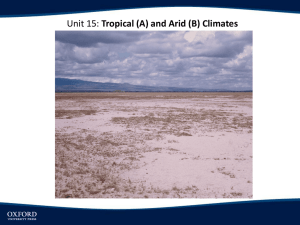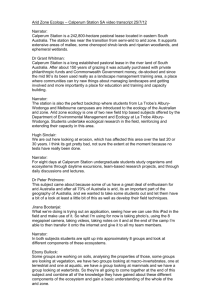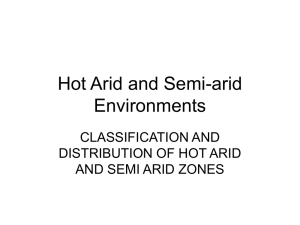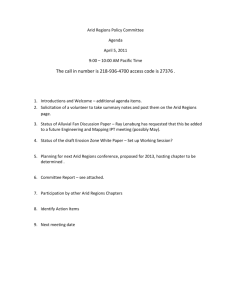major landforms in (semi-)arid regions
advertisement
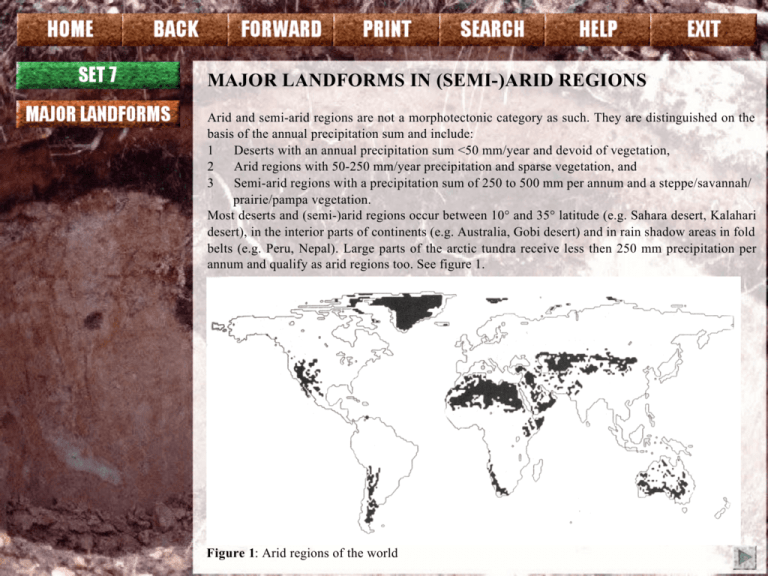
MAJOR LANDFORMS IN (SEMI-)ARID REGIONS Arid and semi-arid regions are not a morphotectonic category as such. They are distinguished on the basis of the annual precipitation sum and include: 1 Deserts with an annual precipitation sum <50 mm/year and devoid of vegetation, 2 Arid regions with 50-250 mm/year precipitation and sparse vegetation, and 3 Semi-arid regions with a precipitation sum of 250 to 500 mm per annum and a steppe/savannah/ prairie/pampa vegetation. Most deserts and (semi-)arid regions occur between 10° and 35° latitude (e.g. Sahara desert, Kalahari desert), in the interior parts of continents (e.g. Australia, Gobi desert) and in rain shadow areas in fold belts (e.g. Peru, Nepal). Large parts of the arctic tundra receive less then 250 mm precipitation per annum and qualify as arid regions too. See figure 1. Figure 1: Arid regions of the world Important geomorphic processes in the dry regions of the world differ from those in more humid environments: 1 streams are intermittent or ephemeral (and have very irregular discharges), 2 mass–wasting processes and unconfined sheet floods are prominent, 3 many rivers do not debauch into the sea but end in inland depressions without outlet, 4 salt lakes are a common landscape feature, 5 eolian processes play an important role, particularly in areas below the 150 mm/year isohyet, and 6 physical weathering processes are prominent whereas hydrolysis of minerals is subdued. Polar and subtropical fronts have shifted southwards in the (geologically) recent past and many regions that are arid today once had a more humid climate. Conversely, many of the present humid regions were much drier in glacial periods, especially between 20,000 and 13,000 BP when eolian processes influenced land formation more than at present. Mass wasting, fluvial processes and eolian processes are the most important landform-shaping factors in arid and semi-arid regions. This chapter will solely discuss mass wasting and fluvial and lacustrine landforms in arid environments; sandy eolian deposits were treated in an earlier chapter and loess deposits will be dealt with later when the major landforms of steppes and prairie regions will be discussed. Mass-wasting processes Mass-wasting processes are associated with strongly accidented terrain, e.g. where tectonic uplift has created mountains, and in areas with steep fault scarps or incised valleys. Mass wasting often produce erosion landforms, such as residual hills or mountains that remain as isolated features in a low-relief plain. The residual elements consist normally of weathering-resistant rocks (e.g. Uluru sandstone, Australia) or are capped with a layer of resistant rock protecting the underlying softer rock from erosion (e.g. Utah, Great Monument National Park). Such a residual hill or table mountain is called an ‘inselberg’ or ‘mesa’. It is called a ‘butte’ if the diameter of the resistant top rock is less than the height of the surrounding terrain. The mountain footslopes, with a low slope angle and consisting of bedrock covered with a thin debris cover are termed ‘pediments’. Contrary to what it is often thought, pediments are erosional landforms because material is moved down the slope. Ultimately, severe erosion may create multiple, deeply incised valleys into soft sedimentary rocks such as shale or marls, and create a ‘badland’. The only depositional landform associated with mass wasting is the ‘talus cone’ or ‘rock debris cone’. In barren deserts or mountains, temperature differences between day and night can be considerable, leading to thermal disintegration of rocks. Salt crystals in the fissures may accelerate the process. Detached fragments of rocks and stones accumulate in debris cones at the foot of the inselberg or mountain. Figure 2. Badland in an arid region. Fluvial landforms in arid and semi-arid regions Fluvial processes in arid regions produce typical landforms that are different in high-relief and lowrelief areas. High-relief areas Where a mountain front borders on a level plain, for instance at a major fault scarp or rift valley boundary, ‘alluvial fans’ are likely to form. These form upon episodic deposition of weathering products at the slope break. Debris flows and sheet floods occur during occasional heavy downpours and discharge from the hinterland via feeder canyons. Erosion products accumulate at the exit point in a typical half-circular cone, the alluvial fan. The cone has a steep gradient and a pattern of unconfined channels that frequently shift over the depositional body. As the water velocity of the protruding river becomes less, its sediment load can no longer be carried and much of it is deposited right at the entrance to the fan. This rapidly blocks the channel, which then sweeps left and right to obviate the obstacle. The result is a low-angle sediment cone. The sediments tend to be coarser at the 'proximal' end of the fan (close to the fan head or apex) than at the 'distal' part (the fan toe, far into the plain). In contrast with ‘common’ braided deposits, mudflows are common constituents of alluvial fans; they are mostly found near the apex of the fan. Low-relief areas Episodic heavy downpours in low-relief areas are often followed by overland flash floods and debris flows that follow existing depressions in the landscape. Such arid-region fluvial valleys are called ‘wadis’. Many wadis that are currently found in desert regions formed during a more humid climatic episode between 13,000 and 8,000 years BP, at the transition from the Last Glacial to the Early Holocene. Wadis in desert regions carry water only after torrential rainstorms that normally occur once in a few years. At the onset of the rains, water can still infiltrate into the soil. As the downpours continue, the supply of water soon exceeds the infiltration capacity of the soil and excess water will is discharged as surface run off: a ‘flash flood’ is set in motion. Slaking and caking of the soil surface enhance surface run-off towards the wadis that become torrential braided streams with a high sediment load. These braided streams have only one channel, but multiple bars. After the downpour, the river will completely dry up again to await the next event. Most wadis connect with dry, salty basins where individual floodplains merge into extensive ‘playas’. These are salty lakes with characteristic properties that will be outlined in the following paragraph. Many inland depression areas in deserts are former lake areas in which open water was present during the early Holocene (see paragraph on Landforms in smectite regions). Former river delta sequences and coastline features (e.g. coastal terraces) may still be visible. Lacustrine landforms in arid and semi-arid regions If a low-lying basin has no outlet, incoming water from (flash) floods evaporates in the basin where its dissolved salts accumulate in the lowest parts. First, CaCO 3 and MgCO 3 precipitate as calcite, aragonite or dolomite. As the brine becomes further concentrated, gypsum (CaSO4.2H2O) segregates, and still later, when the lake is almost dry, halite (NaCl) and other highly soluble salts. Such salt lakes can only evolve where evapotranspiration is greater than the sum of incoming floodwater and precipitation. When a playa dries out completely, the muddy lake floor shrinks and cracks. Accumulated salts crystallise and form crusts on top of the playa floor and in cracks in the surface soil. Much of the accumulated salt stems from evaporitic marine sediments outside the basin; many Mesozoic (Triassic, Jurassic) and Tertiary sediments are very rich in evaporites. It depends on local hydrographic conditions whether a playa is wet around the year or dries out. A playa may stay (almost) permanently wet if it is part of a closed basin that is under the influence of groundwater. Some playas such as the Dead Sea, are fed by perennial rivers and will not dry out either, but their water is so salty that salts precipitate. Laminated evaporites of considerable thickness can form in this way, with lamination reflecting the periodicity of the seasons. The largest evaporite basin formed in recent geological history is the Mediterranean basin. A closed, or almost closed, basin formed when mountain building blocked the Strait of Gibraltar some 6 million years ago. Before the Strait opened again, half a million years later, a layer of 1 kilometre of evaporites had accumulated on the basin floor. Many lakes in present-day arid regions were freshwater lakes in the wet period between 12,000 and 8,000 BP. Terraces and/or shorelines from that period extend well above the present lake or lacustrine plain. The same lakes were completely dry in the arid Late Pleniglacial period (20,000-13,000 BP). Even a comparatively minor climate change can upset sedimentation regimes in arid lands. Arid and semi-arid regions harbour a wide variety of soils that occur also in more humid environments (e.g. Leptosols, Regosols, Arenosols, Fluvisols). Typical dry-zone soils are soils whose formation was conditioned by aridity; accumulation and/or redistribution of anorganic compounds mark such soils. High levels of soluble salts built up in Solonchaks; these soils are particularly common in closed depressions such as playas and inland basins. Solonetz are not marked by a high salt content, but by a high proportion of sodium ions in the soil solution and adsorbed at the cation exchange sites of clay and silt particles. Solonetz occur predominantly in temperate and subtropical, semi-arid regions. Gypsisols shows signs of substantial accumulation of gypsum in the upper metre of soil, Calcisols are marked by accumulation of calcium carbonate. These two Reference Soil Groups are associated with a wide range of landforms, including pediments, lake bottoms, terraces and alluvial fans. Durisols, having a ‘duric’ or ‘petroduric’ horizon that is hardened by silica (SiO 2) cementation, are not exclusive to arid regions but most Durisols occur in drylands, e.g. alongside Calcisols or Gypsisols.




